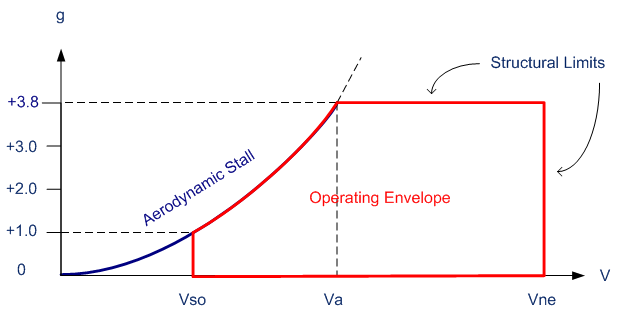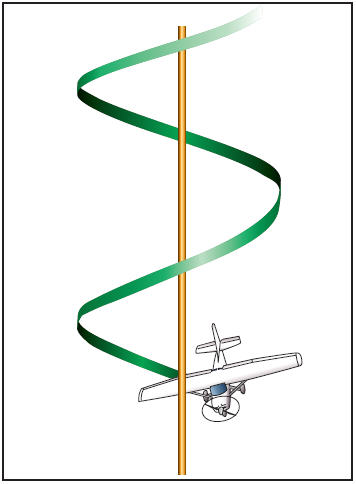Spin training
stall and spin awareness and recovery
This discussion may make your eyes cross, but having a rudimentary understanding of aerodynamics will help you stay out of stall and spin trouble. Bear with me here, it’s only a few paragraphs long, and applying this information in your flying should make you a better pilot.
Here's the ubiquitious disclaimer: This discussion is not intended as a replacement for proper instruction by a qualified, Certificated Flight Instructor, in an airplane approved for spins. It is my recommendation that you take this instruction in an airplane certificated in the Acrobatic category. Now, on to the good stuff...An
aerodynamic stall occurs when the critical angle of attack is exceeded,
that
is, the angle between the chord line and the relative wind exceeds the
maximum (design)
value where the coefficient of lift peaks (the blue line on a lift /
drag
curve, to the left). As the angle of attack increases, airflow over the top
of the
wing begins to detach and becomes turbulent, this separation
transitions from
the trailing edge toward the leading edge (that buffeting you hear or
feel is
that turbulent air impacting the empennage). Beyond the critical angle
of
attack, the wing no longer produces enough lift to support the airplane
in
normal flight. Airplane
design is such
that the nose pitches downward (or towards your feet), sometimes
falling on one
wing or the other, sometimes not (the airplane is unstable in stalled
flight).
This downward pitching moment will reduce the angle of attack, and
restore lift
to the wing, at least momentarily. What we do with the flight controls
during
the pre-stall and stalled flight regime dictates what the airplane does
next.
Many airplanes have a twist to the wing (the angle of incidence decreases from the root to the tip). As the angle of attack increases on these wings, and turbulent/separated airflow begins first near the fuselage and migrates outward, towards the ailerons and wingtips. This provides some degree of aileron control near the critical angle of attack. However, at or beyond the critical angle of attack, ailerons can behave differently than what the pilot intends. What some don’t realize is that a downward deflected aileron, in addition to producing a localized greater angle of attack and increased lift, produces more drag, resulting in adverse yaw (that is, yaw in an unwanted direction). The last thing we need in an already high angle of attack situation is to further increase the angle of attack! Here’s your Get Out of Jail Free Card: Use opposite rudder to lift a wing that has dropped during an aerodynamic stall, or "step on the high wing."
We have plenty of information about when an airplane stalls in unaccelerated flight; that is, when the airplane experiences only a 1g load (like what you’re experiencing as you read this). The Pilot Operating Handbook (POH) or Airplane Flight Manual (AFM) identifies stall speeds (Vs, Vs1, Vso), the airspeed indicator identifies stall with flaps retracted (Vs and often Vs1) as the bottom of the green arc and the in a landing configuration (full flaps, gear down, etc. as Vso), bottom of the white arc. For accelerated flight, the POH or AFM may identify stall speed as a function of angle of bank and/or aircraft weight. Stall speed increases as the angle of bank increases. Stall speed increases as the g load increases. Stall speed increases as the weight increases. “Weight” can be fuel, passengers, and baggage in the airplane, or that weight created by accelerating the airplane, that is, increasing the load factor.
 The
V-g diagram depicts the airplane’s aerodynamic stall speed (at a
specific
weight, usually gross) under a specific load. The V-g diagram identifies
the 1g
stall speed in addition to stall speeds from 0g to the maximum load
limit. Here's a rule-of-thumb calculation that's fairly simple:
Stall speed at a given g value is equal to the stall speed at 1g
times the square root of the given g value. Or for those
mathematical types:
The
V-g diagram depicts the airplane’s aerodynamic stall speed (at a
specific
weight, usually gross) under a specific load. The V-g diagram identifies
the 1g
stall speed in addition to stall speeds from 0g to the maximum load
limit. Here's a rule-of-thumb calculation that's fairly simple:
Stall speed at a given g value is equal to the stall speed at 1g
times the square root of the given g value. Or for those
mathematical types:

Here's an example. The Decathlon stalls at 53 mph. In a 2 g turn, stall speed equals the square root of 2 g's or 1.41 times 53 which is 75 mph (that's 41% greater than the 1g stall speed). This might cook your noodle, but to find the load factor of a certain bank angle, divide 1 by the product of the cosine of the bank angle (g = 1/cos(bank angle)). The V-g diagram defines our operating envelope in stalled and un-stalled flight. The elevator is our control of choice to move us into (and out of) the operating envelope. Use forward elevator to unload the wing (reduce the g-load), thereby reducing the stall speed.
Using the V-g diagram, we see that we can stall the wing at many different airspeeds (depending on g-load). You also probably heard that an airplane can stall in any attitude and airspeed: level flight, straight up, down, banked, and all combinations of these. It’s all about the direction of the relative wind and angle of attack (not about which way to terra firma). Knowing the direction of the relative wind gives us information about aerodynamic stall. Measuring the relative wind and its angle to our wing would be an ideal way to determine how close we are to the critical angle of attack. Unfortunately, many of the General Aviation airplanes we fly don’t have angle of attack indicators. A tool you can use to identify your proximity to the critical angle of attack is the position of the elevator control, be it stick or control yoke. As Allan Cassidy states in Better Aerobatics, “Because elevator position and angle of attack are very closely interdependent during forward flight, the aircraft also always stalls at the same elevator control position.” Try it sometime, its true!

Let’s talk about spins. A spin is an autorotation in stalled flight. It’s described by a helical flight path (see the following graphic excerpted from the Airplane Flying Handbook). This is usually thought of in an earthward direction. Yet a snap roll, a controlled spin, can take place in any direction referenced to the ground. “Autorotation” is that helical flight path that once started, continues until an anti-rotation (anti-spin) control input(s) is applied. Conversely, rotation occurs when a control input is applied, and stops when the control input is removed. For a spin to occur, roll (about the longitudinal axis) and yaw (about the vertical axis) are combined (referred to as “coupled”), usually as a result of one action inducing the other. For example, fly in straight and level flight and press the right rudder. The nose of the airplane yaws right and as the outside wing accelerates, it generates more lift and therefore a roll component is generated, or coupled with yaw. Add an aerodynamic stall to this scenario, and you’ve got a spin. Remember, the prime mover in this equation is not the stall, but the yaw/roll or pro-spin couple. Fly coordinated, that is, the ball in the center, and a spin cannot occur.
I’m not going into the four phases of a spin other than to tell you they are called entry, incipient, developed, and recovery (their names generally describe the characteristics of each phase). You can find a description of these in the FAA’s Airplane Flying Handbook and elsewhere.
You should know how to tell when you’re in fully developed spin. Airspeed hovers low on the airspeed indicator, maybe about 5 – 10 mph above stall (unlike a spiral where airspeed builds quickly). Descent rate is in the neighborhood of 5,000 – 8,000 feet per minute (fpm). Hands off (upright spin), the controls float in the direction of the spin. If you have a turn coordinator, you can look at the little airplane representation; it will tell you the direction of rotation. The ball cannot be relied on to indicate the direction of spin. Flow of scenery in the windshield can be used to indicate spin direction: If it appears to be flowing from left to right, you’re spinning left; flowing right to left, you’re spinning right.
Before discussing the recovery phase, you should know that unless you’re flying an airplane certificated in the Acrobatic category, it is possible for a Normal category airplane (and some Utility category airplanes) in a fully developed spin to be unrecoverable. The airplane can become inertially locked into the spin. No amount of anti-spin control input will recover from the spin. Big Trouble. In this Normal category single-engine aircraft, a spin in an incipient phase is defined in FAA certification parlance as one turn or three seconds of rotation. Recovery must be accomplished in not more than one additional turn.
Read your POH/AFM; it has the definitive steps to exit from a spin. Short of those steps, NASA studied spins ad nauseam (no pun intended) and came up with four steps which can be used for upright spin recovery in a typical light, single-engine, general aviation airplane:
1. Power – IDLE
2. Ailerons – NEUTRAL (and flaps up if equipped)
3. Rudder – FULL OPPOSITE TO SPIN AND HOLD
4. Elevator – PUSH THROUGH NEUTRAL
These inputs are maintained until rotation stops, then:
5. Rudder – NEUTRAL
6. Elevator – RECOVER FROM DIVE
The acronym PARE can be used to help you remember this spin recovery process.
That’s a very short discussion (it only seemed long) of stall and spin awareness and recovery. There are many sources on the subject with an abundance of information. Some of my favorites include the following:
- The Light Airplane Pilot’s Guide to Stall/Spin Awareness, Rich Stowell
- Better Aerobatics, Alan Cassidy
- Emergency Maneuver Training, Rich Stowell
- Airplane Flying Handbook, FAA
- The Flight Instructor’s Manual, William K. Kershner
- Stall/Spin: Entry Point for Crash and Burn?, Air Safety Foundation
- Stall and Spin Awareness Training, Advisory Circular 61-67C, FAA
